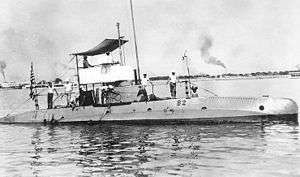USS B-2 (SS-11)
 USS B-2 off Cavite Navy Yard, the Philippines, circa 1913-1917. | |
| History | |
|---|---|
| Name: | USS B-2 |
| Builder: | Fore River Shipbuilding Company in Quincy, Massachusetts |
| Cost: | $187,982.32 (hull and machinery)[1] |
| Launched: | 1 September 1906 |
| Commissioned: | 18 October 1907 |
| Decommissioned: | 12 December 1919 |
| Fate: | Sunk as a target |
| General characteristics | |
| Class and type: | B-class submarine |
| Displacement: |
|
| Length: | 82 ft 5 in (25.12 m) |
| Beam: | 12 ft 6 in (3.81 m) |
| Draft: | 10 ft 7 in (3.23 m) |
| Installed power: |
|
| Propulsion: |
|
| Speed: |
|
| Range: |
|
| Test depth: | 150 feet (45.7 m) |
| Complement: | 10 officers and enlisted |
| Armament: | 2 × 18 in (460 mm) bow torpedo tubes (4 torpedoes) |
USS B-2 (SS-11) was one of three B-class submarines built for the United States Navy in the first decade of the 20th century.
Description
The B-class submarines were enlarged versions of the preceding Plunger class. They had a length of 82 feet 5 inches (25.1 m) overall, a beam of 12 feet 6 inches (3.8 m) and a mean draft of 10 feet 7 inches (3.2 m). They displaced 145 long tons (147 t) on the surface and 170 long tons (170 t) submerged. The B-class boats had a crew of one officer and nine enlisted men. They had a diving depth of 150 feet (45.7 m).[2]
For surface running, they were powered by one 240-brake-horsepower (179 kW) gasoline engine that drove the single propeller shaft. When submerged the propeller was driven by a 115-horsepower (86 kW) electric motor.[2] The boats could reach 9 knots (17 km/h; 10 mph) on the surface and 8 knots (15 km/h; 9.2 mph) underwater. On the surface, they had a range of 540 nautical miles (1,000 km; 620 mi) at 9 knots (17 km/h; 10 mph) and 12 nmi (22 km; 14 mi) at 4 knots (7.4 km/h; 4.6 mph) submerged.[3]
The B-class boats were armed with two 18-inch (45 cm) torpedo tubes in the bow. They carried two reloads, for a total of four torpedoes.[3]
Construction and career
B-2 was laid down by Fore River Shipbuilding Company in Quincy, Massachusetts, under subcontract from Electric Boat Company of New Suffolk, L. I., as Cuttlefish, making her the first ship of the United States Navy to be named for the cuttlefish, a 10-armed marine mollusk similar to the squid.
Cuttlefish was launched on 1 September 1906 sponsored by Ms. Eleanor Gow, daughter of Commander J. L. Gow, and commissioned on 18 October 1907 with Lieutenant E. J. Marquart in command. She reported to the Second Submarine Flotilla, Atlantic Fleet.
Cuttlefish operated along the Atlantic coast, running experiments, testing machinery and equipment, and conducting extensive training exercises until going into reserve at Charleston Navy Yard on 30 November 1909. Recommissioned on 15 April 1910, she served with the Atlantic Torpedo Fleet until joining the Reserve Torpedo Group at Charleston Navy Yard on 9 May 1911. The boat was renamed B-2 on 17 November. B-2 remained in reserve until placed out of commission on 4 December 1912. On 6 December, she was towed to Norfolk, Virginia, and loaded onto Ajax for transfer to the Asiatic Station. Sailing via the Suez Canal, Ajax arrived at Cavite, Philippine Islands on 30 April 1913, and B-2 was launched on 12 May. She was recommissioned on 2 August and assigned to the Torpedo Flotilla, Asiatic Fleet. She remained on duty in the Philippines until decommissioned at Cavite on 12 December 1919. B-2 was subsequently used as a target.
Notes
References
- Friedman, Norman (1995). U.S. Submarines Through 1945: An Illustrated Design History. Annapolis, Maryland: Naval Institute Press. ISBN 1-55750-263-3.
- Gardiner, Robert & Gray, Randal, eds. (1984). Conway's All the World's Fighting Ships: 1906–1921. Annapolis, Maryland: Naval Institute Press. ISBN 0-85177-245-5.
This article incorporates text from the public domain Dictionary of American Naval Fighting Ships. The entry can be found here.